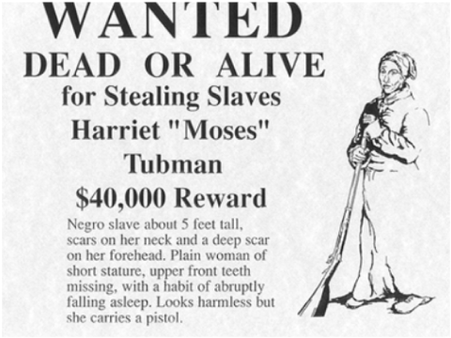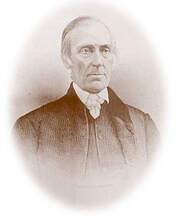The North Star or Polaris is the first and one of the brightest stars to appear in the night sky. It is the only star in the constellation that does not move across the sky or change position with the seasons; it always points to the north. Polaris is easily identified by first finding the Big Dipper or the Drinking Gourd. The Big Dipper is made up of seven bright stars in the shape of a ladle with a curved handle. Away from the handle is the side of the bowl that forms the pouring edge. The two stars making up the Big Dipper’s pouring edge points to the North Star.
The term “Underground Railroad” was first used in 1831. A Kentucky slave named Tice Davids fled his plantation with his master in hot pursuit. Tice jumped into the Ohio River determined to swim to Ripley, Ohio, on the other shore. Pursued by his master in a boat, Tice made it to shore. When his master reached the shore, however, Tice was nowhere to be found. The frustrated slave-owner declared that Tice had vanished before his very eyes disappearing on some kind of Underground Railroad.
The Underground Railroad (also called the Liberty Line) was not underground nor did it have tracks. Rather it was a movement begun by Quakers, as early as 1676, (due to George Fox the founder of Society of Friends also known as the Father of Quakerism) to help slaves escape their bondage in the United States to freedom in the free northern states and later to Canada by following the North Star. Acting as “conductors,” Quakers, Free Blacks, Whites, Native Americans, German farmers and other slaves helped fugitive slaves to escape. Although the Underground Railroad was formally developed until the early 19th century, slaves had been using the same routes to escape slavery for decades.
In the United States the Fugitive Slave Act was passed in 1793 which protected the rights of slave owners for retrieving their property - runaway slaves. This act allowed slave hunters to capture an escaped slave only to confirm orally before a state or federal judge that the slave was a runaway. Slaves were not entitled to a trial by jury and a person hiding an escaped slave could be fined $500.00 and/or be imprisoned.
Southerners were outraged that escaping slaves received assistance from so many sources and that they lived and worked in the free Northern States and in Canada. As a result, a much stronger act was implemented, the Fugitive Slave Act of 1850. This new Fugitive Slave Act made it both possible and profitable to hire slave catchers to find and arrest runaways. Slave owners could choose to have slaves returned or killed outright. Slaves were considered property, not people, and thus had no rights to life or liberty.
Furthermore, those aiding a fugitive were at risk of imprisonment as well as a $1,000 fine. This was a disaster for the free Black communities of the North, especially since the slave catchers often kidnapped legally-freed Blacks as well as fugitives. But these seizures and kidnappings brought the brutality of slavery into the North and persuaded many more people to assist fugitives. As a result, slaves used whatever means necessary to try even harder to escape their bondage.
During the 1830s and 1840s, about 20 terminals were set up in Canada dotted along the shores of Lake Erie.
“Steal Away to Jesus,” this song communicates that the person singing is planning to escape.
“Wade in the Water, Children,” Tubman used this song to tell slaves to get into the water to avoid being tracked. This is an example of a map song, where directions are coded into the lyrics.
“Sweet Chariot,” a slave hearing this song knew to be ready to escape, a band of angels are coming to take him to freedom. The Underground Railroad (sweet chariot) is coming south (swing low) to take the slave to the north or freedom (carry me home). This was one of Tubman’s favorite slave spirituals.
A legendary conductor on the Underground Railroad was Harriet Ross Tubman. Known as the “Black Moses” of her people, Tubman was born into slavery around 1820 in Maryland. She made about 19 trips from Pennsylvania to free northern states and into Canada, leading 300 slaves to freedom. As a signal to the slaves that she was about to make a trip, Tubman would sing “Up with Moses” the day before she left. While hiding out along the route, Tubman would signal whether it was safe or not by singing - a sad song meant the escapees had to hide, a happy song that they were safe.
Tubman lived in St. Catharines, Ontario for about eight years. This remarkable woman also fought for women’s rights, the elderly. Tubman returned to the United States to serve as scout, spy and nurse in the Union Army during the American Civil War. Tubman is the first and only woman to have led American troops in war. She died in 1913 at the age of 93.
The Underground Railroad had three main routes. One ran from the eastern Upper South through Philadelphia and New York State into Canada. The other route involved stowing fugitives on ships leaving the southern East Coast towns like Charlestown, South Carolina, Portsmouth, Virginia and heading north. The ships would dock in a northern city like New York City or New Bedford, Massachusetts and the runaway slaves would then travel through New England and into Canada. The western Underground Railroad route had fugitives leaving Kentucky, Tennessee, Missouri and even the Deep South via the Mississippi River. Runaway slaves would cross into the Free states then journey to Canada by crossing the Great Lakes. Fugitives, who crossed over land, would stop at various terminals situated in Detroit, Michigan.
For many escaped slaves, Canada represented a dream of freedom where slave catchers and lynch mobs could not hurt and/or kill them. Escaping slaves on the Underground Railroad endured months and even years living like fugitives, while bounty hunters and racist government policies were always trying to impede their flight to freedom.
Once in Canada, life was not without difficulties. Just like their American cousins, many white Canadians held severely racist views of their new black neighbours. While most people were generous and helped the new settlers, some Canadians turned a blind eye to their struggles and in some cases assaults and murders against black immigrants were recorded. However, these were in the minority.
Although free, escaped slaves did not enjoy equal privileges and opportunities as their white neighbors. Finding work as a black man or woman was a difficult task and opportunities for education were slim. Blacks were forced to build their own churches, schools, and community centers because they were not welcomed in white communities. As a result, many escaped slaves lived in tight knit black communities where poor living conditions and sanitation led to disease and eventually death.
Black Canadians were part of the growth of Canada, particularly in the key boom years of the 1870’s, following the American Civil War, when Canada aggressively expanded to the west. Many blacks, tired of the racism of the east, joined the wave of European settlers moving to the prairies and were key components in establishing today’s thriving cities of Winnipeg, Calgary and Vancouver.
Black Canadians have since become a part of Canada’s history. The descendants of the runaway slaves who escaped bondage to freedom by following the North Star, have fought in Canada’s wars - William Hall V.C. (1825-19040), have become hockey stars - Willie Eldon O'Ree (born October 15, 1935 - Present), have contributed to the arts and culture - Oscar Emmanuel Peterson (1925-2007), have shared in building great centers of research and innovation - Elijah McCoy
(1844–1929), and have even served in the highest offices of the federal government - Lincoln MacCauley Alexander (1922-2012).









 RSS Feed
RSS Feed
